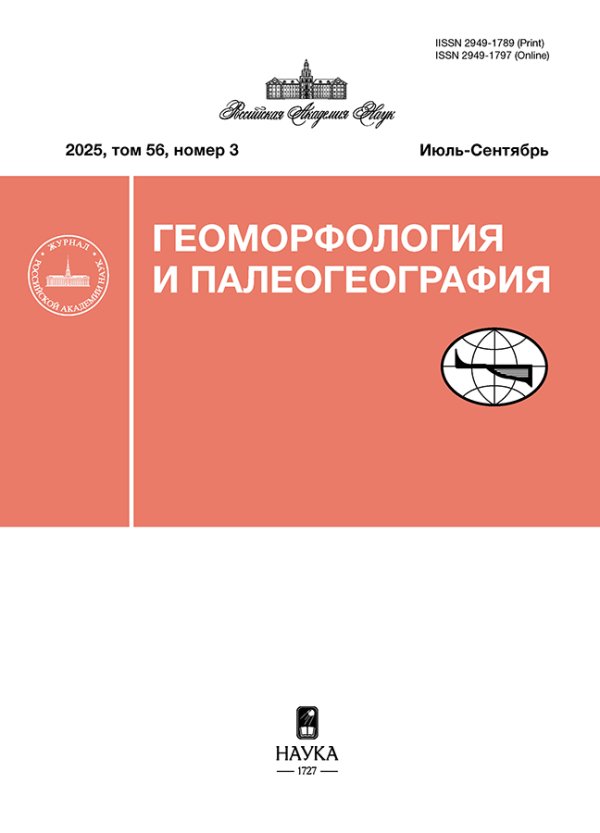FORMATION OF RIVER DELTAS OF INTRA-CONTINENTAL RESERVOIR OF THE ARAL-CASPIAN ARID ZONE (ON THE EXAMPLE OF THE TEREK, AMUDARYA AND ILI RIVERS)1
- Authors: Korotaev V.N.1
-
Affiliations:
- Lomonosov Moscow State University, Faculty of Geography
- Issue: Vol 54, No 3 (2023)
- Pages: 3-13
- Section: REVIEW ICLES
- URL: https://journals.rcsi.science/2949-1789/article/view/140579
- DOI: https://doi.org/10.31857/S2949178923030040
- EDN: https://elibrary.ru/WCWFQU
- ID: 140579
Cite item
Full Text
Abstract
The study of the geomorphological and sedimentary systems forming at mouth of large rivers flowing into the inland seas and lakes of the arid zone shows that they have passed a long evolutionary path of development, repeatedly accumulating and reworking alluvial deposits depending on the position of the receiving reservoir level. Following the level fluctuations, the rivers moved their deltas, Pleistocene relics of which are found in the range of absolute marks from +50 to –20 m on the shores of the Caspian Sea, from +50 to 110 m of the Aral Sea and from +370 to 400 m of Lake Balkhash.
The Aral-Caspian arid zone is distinguished by following natural factors affecting the processes of delta formation: aridity of the climate, formation of river flow in the upper reaches and lack of inflow in the lower reaches, increased water turbidity and a huge runoff of suspended sediments, as well as significant influence of human economic activity associated with intensive irrigation. The most common morphogenetic type of river deltas on the coasts of intracontinental reservoirs of the arid zone are huge alluvial outflow cones in the form of extension deltas and “dry internal deltas” in the form of alluvial outflow cones.
The delta arms and the lower reaches of the rivers of the arid zone are characterized by a high intensity of channel deformations due to weak resistance to erosion of fine-grained valley alluvial-proluvial deposits, high flow velocities and high saturation of the flow with suspended sediments. The oversaturation of the river flow with sediments usually leads to shallowing of the riverbed in high water and its gradual increase over the surrounding terrain. An increase in the bottom elevation and fast delta progradation provoke frequent breakthroughs of the riverbed shafts, a change in the direction of the flow of delta arms, the creation of new branching nodes and the formation of regional jointed deltas of the breakthrough type (delta blades) on the periphery of the old delta (subdelta according to American terminology). Partially superimposed or superimposed deltas can also form inside delta systems after the breakthroughs of channel shafts (or enclosing dams).
The poor preservation of ancient deltas is noted due to intensive economic development and high dynamics of the coast and the hydrographic network of river deltas in conditions of huge runoff of suspended sediments and significant variability of the level of the receiving reservoir.
About the authors
V. N. Korotaev
Lomonosov Moscow State University, Faculty of Geography
Author for correspondence.
Email: vlaskor@mail.ru
Russia, Moscow
References
- Alekseevskij N.I., Mikhajlov V.N., Sidorchuk A.Yu. (1987). Protsessy del’toobrazovaniya v ust’evoi oblasti Tereka (Delta formation processes in the mouth area of the Terek). Vodnye resursy. No. 5. P. 123–128. (in Russ.)
- Bajdin S.S., Skriptunov N.A., Shtejman B.S., Gan G.N. (1971). Gidrologiya ust’evykh oblastei Tereka i Sulaka (Hydrology of the Terek and Sulak mouth areas). M.: Gidrometeoizdat (Publ.). 198 p. (in Russ.)
- Belyaev I.P. (1963). Gidrologiya del’ty Tereka (Hydrology of the Terek Delta). M.: Gidrometeoizdat (Publ.). 208 p. (in Russ.)
- Egorov V.V. (1960). Formirovanie del’ty Amudar’i i vozmozhnye izmeneniya ee gidrograficheskoi seti (Formation of the Amu Darya delta and possible changes in its hydrographic network). Trudy Okeanograf. komissii. T. VI (Izuchenie ust’ev rek). M.: Acad. Sc. USSR (Publ.). P. 86–88. (in Russ.)
- Gidrologiya ust’ev rek Tereka i Sulaka (Hydrology of the Terek and Sulak River Mouths). (1993). M.: Nauka (Publ.). 160 p. (in Russ.)
- Kaplin P.A. (1973). Noveishaya istoriya poberezhii Mirovogo okeana (Recent history of the coasts of the World Ocean). M.: Moscow State University Publishing House. 265 p. (in Russ.)
- Kaplin P.A., Selivanov A.O. (1999). Izmeneniya urovnya morei Rossii i razvitie beregov: proshloe, nastoyashchee, budushchee (Changes in the sea level of Russia and coastal development: past, present, future. M.: GEOS (Publ.). 299 p. (in Russ.)
- Korotaev V.N. (2012). Ocherki po geomorfologii ust’evyh i beregovyh sistem (Essays on the geomorphology of mouth and coastal systems. M.: Moscow State University Publishing House. 540 p. (in Russ.)
- Krylov P.S., Nurgaliev K., Asonov P.G. (2014). Ob istorii razvitiya ozera Balhash (Kazahstan) po seismoakusticheskim dannym (On the history of the development of Lake Balkhash (Kazakhstan) according to seismoacoustic data). Uchenye zapiski KazSU. Estestvennye nauki. T. 156. Kn. 1. P. 128–134. (in Russ.)
- Leont’ev O.K. (1961). Drevnie beregovye linii chetvertichnykh transgressii Kaspiiskogo morya (Ancient coastlines of Quaternary transgressions of the Caspian Sea). Trudy Institute of Geology Acad. Sc. Est. SSR. No. VIII. P. 45–62. (in Russ.)
- Leont’ev O.K., Chekalina T.I. (1979). Novokaspiiskaya transgressiya i perestroika morskogo kraya Terskoi del’ty (Novokaspian transgression and restructuring of the sea area of the Terek Delta). Kompleksnye issledovaniya Kaspiiskogo morya. M.: Moscow State University Publishing House. Vol. 6. P. 3–11. (in Russ.)
- Lokhin M.Yu., Maev E.G. (1990). Pozdnepleistocenovye del’ty na shel’fe severnoi chasti Srednego Kaspiya (Late Pleistocene deltas on the shelf of the northern part of the Middle Caspian). Vestn. Mosk. Univ. Ser. 5. Geografiya. No. 3. P. 34–40. (in Russ.)
- Lopatin D.V. (1960). Osobennosti formirovaniya del’tovoi oblasti Amu-Dar’i (Features of the formation of the delta area of the Amu-Darya). Trudy Okeanograf. komissii. T. VI (Izuchenie ust’ev rek). M.: Acad. Sc. USSR (Publ.). P. 9–19. (in Russ.)
- Lymarev V.I. (1967). Berega Aral’skogo morya – vnutrennego vodoema aridnoi zony (The shores of the Aral Sea are an internal reservoir of the arid zone). L.: Nauka (Publ.). 252 p. (in Russ.)
- Reki i ozera mira (Enciklopediya). (2012). M.: Enciklopediya (Publ.). 928 p. (in Russ.)
- Rogov M.M. (1957). Gidrologiya del’ty Amudar’i (Hydrology of the Amu-Darya Delta). L.: Gidrometeoizdat (Publ.). 255 p. (in Russ.)
- Rychagov G.I. (1960). Vozrast del’ty Tereka (Age of the Terek Delta). Trudy Oceanographer. Commission of the USSR Academy of Sciences. T. VI (Study of river mouths). M.: Acad. Sc. USSR (Publ.),. P. 86–88. (in Russ.)
- Rychagov G.I. (1977). Pleistotsenovaya istoriya Kaspiiskogo morya (Pleistocene history of the Caspian Sea). Moscow: Publishing House MSU. 267 p. (in Russ.)
- Sapozhnikov D.G. (1951). Sovremennye osadki i geologiya ozera Balhash (Modern sediments and geology of Lake Balkhash). M.: Acad. Sc. USSR (Publ.). 207 p. (in Russ.)
- Sevast’yanov D.V., Mamedov E.D., Rumyancev V.A. (1991). Istoriya ozer Sevan, Issyk-Kul’, Balhash, Zaisan i Aral (History of lakes Sevan, Issyk-Kul, Balkhash, Zaysan and Aral). L.: Nauka (Publ.). 304 p. (in Russ.)
- Svarichevskaya Z.A. (1965). Geomorfologiya Kazakhstana i Srednei Azii (Geomorphology of Kazakhstan and Central Asia). L.: LSU (Publ.). 296 p. (in Russ.)
Supplementary files













